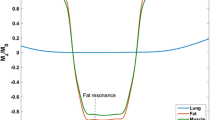Abstract
The unique characteristics of the human lung arising from low proton density and multiple air-tissue interfaces of the alveoli cause difficulty in1H lung magnetic resonance imaging. In addition, the dominating signal from sources such as the thoracic muscle and subcutaneous fat hampers the visualization of the lung parenchyma. In this contribution, an efficient tissue suppression technique is presented which allows one to significantly enhance lung parenchyma visibility. A short inversion time inversion recovery (STIR) experiment combined with a magnetization transfer (MT) experiment was used for magnetization preparation in order to suppress the signal from muscle. A half-Fourier single-shot turbo spin-echo sequence was used as acquisition module. This approach was used to perform lung anatomical imaging in eight healthy human subjects and five patients withcystic fibrosis. The results obtained demonstrate that with MT-STIR approach high quality human lung images can be obtained and that this approach has the potential for the evaluation of lung pathologies.
Similar content being viewed by others
References
Mai VM, Knight-Scott J, Berr SS. Improved visualization of the human lung in 1 H MRI using multiple inversion recovery for simultaneous suppression of signal contributions from fat and muscle. Magn Reson Med 1999;41:866–70.
Mai VM, Knight-Scott J, Edelman RR, Chen Q, Keilholz-George S, Berr SS. 1 H magnetic resonance imaging of human lung using inversion recovery turbo spin echo. J Magn Reson Imaging 2000;11:616–21.
Jakob PM, Wang T, Hebestreit H, et al. Cystic fibrosis: combined functional and anatomical lung 1 H imaging—preliminary results and important observations. In: Proceedings of the Ninth Annual Meeting of ISMRM, Glasgow, 2001, p 1988.
Wolff SD, Balaban RS. Magnetization transfer contrast (MTC) and tissue water proton relaxation in vivo. Magn Reson Med 1989;10:135–44.
Balaban RS, Chesnick S, Hedges K, Samaha F, Heineman FW. Magnetization transfer contrast in MR imaging of the heart. Radiology 1991;180:671–5.
Pike GB, Hu BS, Glover GH, Enzmann DR. Magnetization transfer time-of-flight magnetic resonance angiography. Magn Reson Med 1992;25:372–9.
[7] Tanttu JI, Sepponen RE. A new parameter selective method for MR angiography: combination of T1 and magnetization transfer contrasts. In: Proceedings of the Tenth Annual Meeting of SMRM, San Francisco, 1991, p. 831.
Hajnal JV, Baudouin CJ, Oatridge A, Young IR, Bydder GM. Design and implementation of magnetization transfer pulse sequences for clinical use. J Comput Assist Tomogr 1992;16:7–18.
[9] Baudouin CJ, Hajnal JV, Young IR. Magnetization transfer STIR imaging of the musculoskeletal system. In: Proceedings of the 12th Annual Meeting of SMRM, New York, 1993, p 862.
Jakob PM, Hillenbrand CM, Wang T, Schultz G, Hahn D, Haase A. Rapid quantitative lung 1H T1 mapping. J Magn Reson Imaging 2001;14:795–9.
Hatabu H, Gaa J, Tadamura E, et al. MR imaging of pulmonary parenchyma with a half-fourier single-shot turbo spin-echo (HASTE) sequence. Eur J Radiol 1999;29:152–9.
Mai VM, Chen Q, Li W, Hatabu H, Edelman RR. Effect of respiratory phases on MR lung signal intensity and lung conspicuity using segmented multiple inversion recovery turbo spin echo (MIR-TSE). Magn Reson Med 2000;43:760–3.
Author information
Authors and Affiliations
Corresponding author
Rights and permissions
About this article
Cite this article
Jakob, P.M., Wang, T., Schultz, G. et al. Magnetization transfer short inversion time inversion recovery enhanced1H MRI of the human lung. MAGMA 15, 10–17 (2002). https://doi.org/10.1007/BF02693839
Received:
Revised:
Accepted:
Issue Date:
DOI: https://doi.org/10.1007/BF02693839




